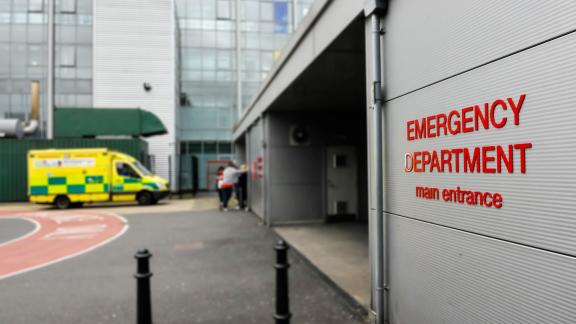Urgent and emergency care plan: what you need to know
Key points
A return to an average 30-minute response time for Category 2 calls by eliminating handover delays of more than 45 minutes, freeing up the equivalent of 550,000 ambulance shifts.
Cutting A&E waits of more than four hours to no more than 22 per cent of the total (down from 25 per cent) and those lasting more than 12 hours down to 10 per cent of attendances.
A particular focus on ensuring children are seen within four hours at A&E, as well as a reduction in the numbers of people in a mental health crisis forced to wait more than 24 hours for ant admission, fewer of which should take place out of area.
Faster discharge for patients who are medically fit to leave hospital, alongside a broader effort to reduce length of stay wherever possible.
Increasing the take-up of vaccinations among frontline staff by a further 5 per cent, returning to levels last seen in 2018/19.
A continued shift of activity out of hospitals, including the elimination of ‘corridor care’, by expanding virtual wards, urgent community response (UCR), and scaling up primary care.
£370 million in capital investment for 40 same-day emergency care (SDEC) centres, as well as dedicated mental health crisis assessment centres to reduce the number of mental health patients needing to seek help via A&E.
The further expansion of Connected Care Records in order to give ambulance crews a more unified picture of patients’ needs, conditions and recent treatment history.

On 5 June 2025, NHS England published its urgent and emergency care plan, which sets out how these services can be improved and maintained over the next 12 months following successive winters where performance dropped to unacceptable levels.
Background
Providing medical care for those in the greatest need lies at the heart of what we expect from the NHS. UEC performance therefore represents the strength of the system as a whole. Yet despite the best efforts of NHS staff, UEC performance fell well below target last winter. Delays in emergency departments (ED) and for ambulances grew significantly, hitting the highest levels seen since 2022/23 and leading to an estimated 16,000 excess deaths. The share of people in A&E waiting more than four hours (which should not exceed 5 per cent) was above 40 per cent in Type 1 (major) EDs by the end of 2024, following a decade of deteriorating performance. With EDs full, ambulances spent over a quarter of their time waiting outside to discharge their patients, unable to respond to other emergencies.
This in turn meant that the average Category 2 response – covering health emergencies, such as strokes –peaked at over 48 minutes during the winter months. This far exceeded the 18-minute mean time set as a target within the NHS Constitution. ‘Car park care’ and ‘corridor care’ alike have eroded both the quality and the experience of care that patients receive.
The worsening logjam in hospitals coupled to growing demand, much of which is not seasonal but year-long, created this chain of delays. In addition, with a rapidly ageing population, demand for UEC will only continue to increase.
Added to this, the renewed focus on maintaining high levels of elective activity so as to reduce waiting lists has also required capacity on wards, further diminishing their ability to admit new patients from ED. Moreover, one-in-seven acute beds and one-in-nine mental health beds are still taken up by people who are medically fit for discharge but who cannot leave until support becomes available in the community.
As well as causing clinical harm, the crisis in UEC is undermining public faith in the NHS as a whole. Staff, too, are paying the price: ambulance crews’ welfare remains among the worst across the whole system
In response, NHS England’s UEC plan outlines the scale of the crisis that engulfed EDs and ambulances alike last winter – as well as the pressures upon them all year round – and sets out how the NHS will try and avoid this from happening again.
Summary
The plan recognises the problems that UEC faces in the NHS and proposes clear and reasonable actions to recover standards building on what many services are doing already. The plan also recognises that this crisis affects the whole system, not simply ambulance trusts and emergency departments, and thereby puts co-operation across the NHS at the heart of improving services. It also aligns with the ‘three shifts’ that we expect to be at the heart of the ten-year plan and which system and provider leaders believe are crucial to putting the NHS back on its feet.
For example, tying out of hospital, local authority and UEC services together through the Better Care Fund (BCF) is a proven means to minimise reliance on the ambulance service when responding to crises such as falls, both within the home and in residential care. Likewise, increasing vaccination uptake through peer learning is already underway, with the NHS Confederation working with local vaccination leads.
This focus on ‘those things we can change now’ is also reflected in the UEC plan’s approach to delayed discharge. Whilst comprehensive reform of adult social care remains essential, the plan accepts that improving performance cannot wait for the results of the Casey Commission in 2026 and 2028 and includes a number of tried and tested solutions that have already been used to good effect.
The plan’s approach to technology, too, blends innovation with optimising what already exists. Introducing natural language processing to improve emergency call streaming, for example, sits alongside making the most of remote monitoring and electronic patient records to improve productivity and the quality of care alike.
Mental health, rightly, also plays a central role with the UEC plan. Co-located crisis centres will both improve the interface between acute and mental health providers whilst also offering space for other partners – such as housing and social enterprises – who are essential to the wider mental health pathway (above all for younger patients).
Building on the 2025/26 capital guidance, the plan details the £75 million investment in reducing out-of-area placements (OAPs) within mental health. Expanded inpatient facilities – in line with the existing Mental Health Commissioning Framework - should reduce the number of OAPs by around 150 per year. However, this target is ambitious. Likewise, greater transformation of the mental health estate (including more step-down beds) will require further capital investment in future. Other mental health priorities within the plan includes a focus on reducing 24-hour waits in A&E. Supplementing the use of UEC Action Cards and ten high-impact actions for mental health discharges guidance, this balances the need to address the longest waits whilst still aiming to move patients out of A&E as soon as it is safe to do so.
Similarly, the plan asks local mental health providers to evidence how they can achieve ‘as short as possible’ length of stays in mental health inpatient wards and to ‘produce their own percentage reduction target of re-admissions for their highest intensity users’ of crisis pathways. Improved sharing of data between acute and mental health providers and primary care can help identify this group and provide proactive care.
Supporting these requires an injection of capital. Whilst the funding included within the plan does not represent new money, it underlines the importance of investment to boost operational productivity. Given the need for a whole-system response to the crisis in UEC, investment in primary care, community services, and the ambulance sector will also lie at the heart of curbing future demand.
Equally, the plan reinforces the shift of care closer to home via a neighbourhood health service, recognising the role that primary care has to play. Improving the interface between primary care and other parts of the system (for example NHS 111) is essential so patients can move seamlessly through the system. This in turn underlines the importance of involving primary care in localised winter planning as early as possible, allowing for the deployment of extra capacity (where needed) in time to have maximum impact.
In summary, the plan accepts that the crisis in UEC cannot continue and proposes a number of practical steps to turn the service around. Making the most of existing tools – from UCR to staff vaccinations, admissions avoidance through the BCF to virtual wards, SDEC to EPRs – to join up different parts of the NHS reflects an understanding that this is a whole-system issue that demands a whole system response.
Nonetheless, the scale of the challenge for the NHS remains vast. With limited extra investment and faced by ever-worsening demographics, the underlying model of UEC itself is coming under more and more stress every year. Breaking the cycle of winter crises and patient harm may require more than incremental improvements to the status quo in years to come.
How we’re supporting our members
As the only organisation representing the whole of the NHS, the NHS Confederation is committed to supporting its members surmount the challenge of improving UEC performance. Both inside and outside of hospital, we’re proposing the new model of care that the NHS needs to adopt to meet the demands of tomorrow – whilst simultaneously helping our members to make it a reality.
- Our dedicated ED/MH Interface Programme is bringing together acute and mental health teams from across the country. In partnership with NHS England's Mental Health Improvement Support Team, this seeks to strengthen and encourage cross-system working by supporting practical, real-time testing of improvement ideas across these boundaries.
- We’re continuing to press for greater capital investment in the NHS in order to boost productivity throughout the system. As well as securing a welcome £3.1 billion in additional funding from the autumn 2024 Budget, the NHS Confederation is developing new models that can ensure that the right investment reaches the right part of the system with the speed that wholesale transformation requires.
- Our report on The Future of Primary Care has given a platform to some of our most innovative leaders and practitioners, sharing their vision of how primary care can expand and reach its full potential – improving the quality of care and reducing demand elsewhere in the system.
- Achieving the left shift is essential in order to manage demand on UEC services in future years: our recent report on its progress highlights the key enablers to making it happen and showcases some exemplary organisations whose leaders are already achieving results.
- Our programme of work on neighbourhood health is supporting local areas with implementation and the role of communities in supporting their health and wellbeing
- Working with primary care provider collaborative leaders around the country we are demonstrating the power of primary care at scale in supporting the management of system challenges including urgent & emergency care.
- Ahead of the delegation of vaccination services to ICBs in April 2026, the NHS Confederation is working in collaboration with the Association of the British Pharmaceutical Industry (ABPI) to develop a new interactive resource for members that showcases effective vaccination delivery models, for all vaccination programmes, including for staff and the critical success factors to support the effective delegation of these services.



